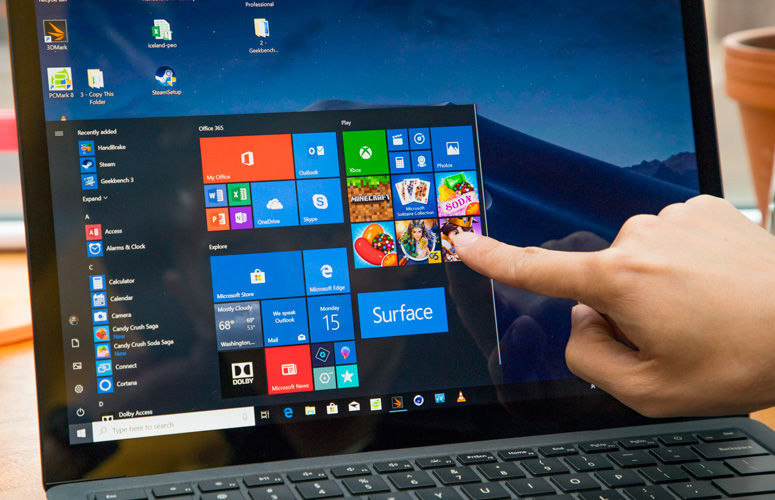Apple Silicon MacBooks aren't getting touchscreens — and that's a good thing
Touchscreens are for iPads and iPhones, not laptops.

MacBooks haven’t had the best time of it recently, what with the terrible butterfly keyboards vastly outstaying their welcome. But things are on the up lately, especially with the new Apple Silicon M1 chips debuting in the new MacBook Air and MacBook Pro.
But one thing MacBooks have totally disregarded over the past several years is the touchscreen. While rival laptop makers scrambled to add touch control to their own machines, Apple has reaffirmed that it doesn’t intend to do so. Which is a very good thing.
- Apple Silicon M1 chips: Everything you need to know
- Don't forget to check out the best Black Friday deals available now
- Just in: Massive Galaxy S21 leak reveals specs for all three models
While it’s always looking like Apple is on the verge of merging one or more of its product lines, it seems there are some lines that it won’t cross. Despite the fact the M1 chip in the new Macs is based on the A series found in iPads and iPhones, there’s no chance of a touchscreen MacBook anytime soon.
This news was confirmed by Craig Federighi, Apple’s senior vice president of software engineering when speaking to The Independent. “I gotta tell you when we released Big Sur, and these articles started coming out saying, ‘Oh my God, look, Apple is preparing for touch’. I was thinking like, ‘Whoa, why?’ We had designed and evolved the look for macOS in a way that felt most comfortable and natural to us, not remotely considering something about touch.”
According to Federighi the familiarity is the strength of Apple’s line-up, since users can swap between devices with “less cognitive load to the switching process” and not “some signaling of a future change in input methods.”
Basically touchscreens aren’t coming to MacBooks for a long time, if ever. Frankly it’s an attitude I wish other laptop-makers would have.
The case against touchscreen laptops

There are arguments to be had both for and against touchscreen laptops, but for me it’s always felt like an awkward feature that’s been added in retroactively without actually considering what it’s supposed to do.
Get instant access to breaking news, the hottest reviews, great deals and helpful tips.
While iOS, iPadOS, and other mobile operating systems have been built with touch in mind from the beginning, Windows and MacOS have not. Instead they had their beginnings decades ago, and have fully integrated a system that’s based on keyboards and mice cursors — not the stubby little digits we call fingers. For that reason I’ve always found laptop touchscreens completely counterintuitive, because most of the icons are too small for my fingers to be completely accurate.
Not to mention the fact that the increasingly small bezels mean I can’t adjust my screen without accidentally toggling something in the process. The same goes for getting rid of smudges and other debris the display can accumulate.
Laptop makers don’t have touchscreens on all their machines, but it seems like all the good ones push it on you as standard. Apple, thankfully, has not done that, and if I didn’t dislike macOS quite so much it would be one of the things that would save me the hassle of disabling touch control in Windows 10’s control panel. While I still can, at any rate.
No doubt people will disagree with me, but there are other reasons why Apple is so against adding touchscreens to MacBooks.
There needs to be space for the iPad

Apple has really been pushing the iPad (and iPad Pro in particular) as the successor to the laptop in recent years, adding more productivity-centric hardware and features to make the tablet more appealing for working on. Those efforts come across as rather half-hearted, because despite Apple’s insistence that iPads are better, it can’t realistically make that vision a reality while MacBooks exist.
That being said, MacBooks and iPads are very different devices, because obviously one is a laptop and one is a tablet — no matter how many accessories you can buy to make it look otherwise. But the key thing that stops those lines getting increasingly blurred is the touchscreen. Add a touchscreen to a MacBook and suddenly the iPad may well seem less appealing.
At the very least it undoes a lot of the effort Apple has put in to position the iPad as a desirable laptop alternative. Because as much as it won’t abandon the MacBook, it’s not going to give it special features that would, in all likelihood, help make the iPad obsolete. It’s not good business to outdo your own products, after all.
Outlook
Is the MacBook always going to remain touchscreen-free? Never say never, but Apple isn't really one to only think in the short term, so it’s not going to be happening for quite a long time. Those of you who were really holding out for a touchscreen MacBook are no doubt disappointed, but at least there’s the iPad Pro.
As adamant that Apple is that this line will never be crossed, the other lines between Macs and iPads are getting increasingly blurred with time.

Tom is the Tom's Guide's UK Phones Editor, tackling the latest smartphone news and vocally expressing his opinions about upcoming features or changes. It's long way from his days as editor of Gizmodo UK, when pretty much everything was on the table. He’s usually found trying to squeeze another giant Lego set onto the shelf, draining very large cups of coffee, or complaining about how terrible his Smart TV is.
